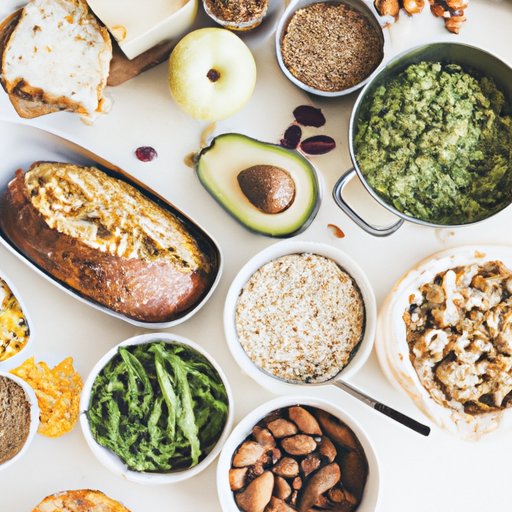
Introduction
Are you considering adopting a vegan lifestyle, but don’t know where to start? This article will guide you step-by-step on how to transition to a vegan diet. We’ll explore the benefits of a vegan diet, food swaps for non-vegan foods, meal planning, protein substitutes, healthy snacking, grocery lists, and sustainability. By the end of this article, you’ll have all the resources you need to kickstart a healthy and sustainable vegan lifestyle.
Why Choose a Vegan Diet?
Choosing a vegan diet can align with one’s ethical and moral beliefs. Animal agriculture is a leading contributor to environmental issues such as greenhouse gas emissions, water use, and deforestation. In addition, animals raised for meat and dairy suffer cruel and inhumane treatment in factory farms.
According to a report by the Food and Agricultural Organization of the United Nations, animal agriculture accounts for 18% of greenhouse gas emissions, more than the entire transportation sector combined. By choosing a vegan diet, individuals can reduce their carbon footprint and contribute to a more sustainable environment.
Additionally, a vegan diet has numerous health benefits. Studies have shown that a vegan diet can lower the risk of heart disease, certain types of cancer, and type 2 diabetes. Vegans tend to have lower cholesterol levels and blood pressure than non-vegans.
Food Swaps
One of the biggest concerns for people transitioning to a vegan diet is finding alternatives to common non-vegan foods. Luckily, there are plenty of vegan-friendly options that can substitute for meat, dairy, and eggs.
Meat alternatives include tofu, tempeh, seitan, and legumes such as chickpeas, lentils, and black beans. These options are not only rich in protein, but also contain essential vitamins and minerals such as iron, calcium, and zinc.
Dairy alternatives include plant-based milks such as soy, almond, and oat milk. These are fortified with calcium and vitamin D to ensure adequate intake. Vegan cheese alternatives and yogurts can also be found at most grocery stores.
Egg alternatives include tofu scrambles, chickpea flour, and flaxseed. These alternatives can be used in baking and cooking just as eggs would be.
Vegan Meal Plans
Creating a balanced vegan meal plan is essential for meeting all necessary nutrient requirements. A balanced vegan meal should include a source of protein, carbohydrates, healthy fats, and vegetables or fruit.
For breakfast, try a tofu scramble with whole-grain toast, avocado, and fruit. For lunch, a quinoa salad with mixed greens, roasted vegetables, and chickpeas is a great option. For dinner, lentil soup with a side salad and whole-grain bread is a filling and nutritious meal.
It’s important to include sources of protein such as beans, lentils, tofu, and tempeh in meals. Consuming healthy fats such as avocado, nuts, and seeds is also important for brain health and satiety.
Protein Substitutes
Many people are concerned about getting enough protein on a vegan diet. However, there are plenty of plant-based protein sources that can provide all necessary amino acids.
Legumes such as beans, lentils, and chickpeas are a great source of protein and fiber. Tofu and tempeh are also protein-rich options. Quinoa, hemp seeds, chia seeds, and nuts are also good sources of protein and healthy fats.
Healthy Snacking
Snacking is an important part of a healthy diet, but it’s important to choose snacks that are high in nutrients to fuel the body. Vegan snacks such as fruit and nut butter, hummus and veggie sticks, or roasted chickpeas are filling and nutritious options. Protein bars made with natural and whole-food ingredients are also great options for on-the-go snacking.
Making your own vegan snacks at home can be fun and easy. Try making energy balls with dates and nuts, kale chips with nutritional yeast, or roasted edamame with sea salt for a satisfying snack.
Grocery Lists
When starting a vegan diet, it’s important to plan ahead and have a well-stocked pantry. A vegan grocery list should include plenty of fruits and vegetables, whole grains, legumes, nuts, seeds, and plant-based milks and yogurts.
It’s important to read labels carefully and watch out for hidden animal-based ingredients such as gelatin and honey. Many grocery stores now carry vegan-friendly products and alternatives such as vegan burgers, sausages, and cheese.
Sustainability
Adopting a vegan lifestyle not only benefits personal health but also benefits the environment. As mentioned earlier, animal agriculture is a leading contributor to environmental issues such as climate change, water use, and deforestation.
By choosing a vegan diet, individuals can reduce their carbon footprint and contribute to a more sustainable future. Additionally, a plant-based diet requires significantly less water and land use than a diet that includes animal products.
Conclusion
Transitioning to a vegan diet doesn’t have to be difficult. By making simple swaps and following basic meal planning principles, anyone can adopt a healthy and sustainable vegan lifestyle. Whether it’s for ethical, health, or environmental reasons, choosing a vegan diet can have a positive impact on both the individual and the planet.
For more resources and guidance on transitioning to a vegan lifestyle, check out vegan blogs and cookbooks, consult with a registered dietitian, and connect with local vegan communities.





